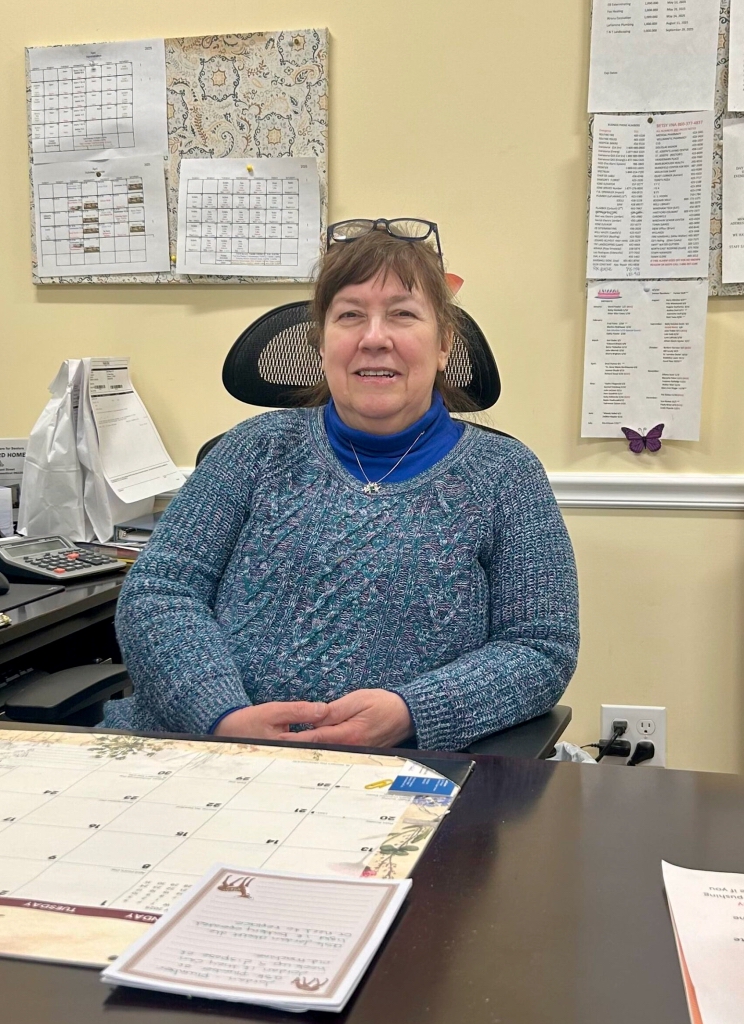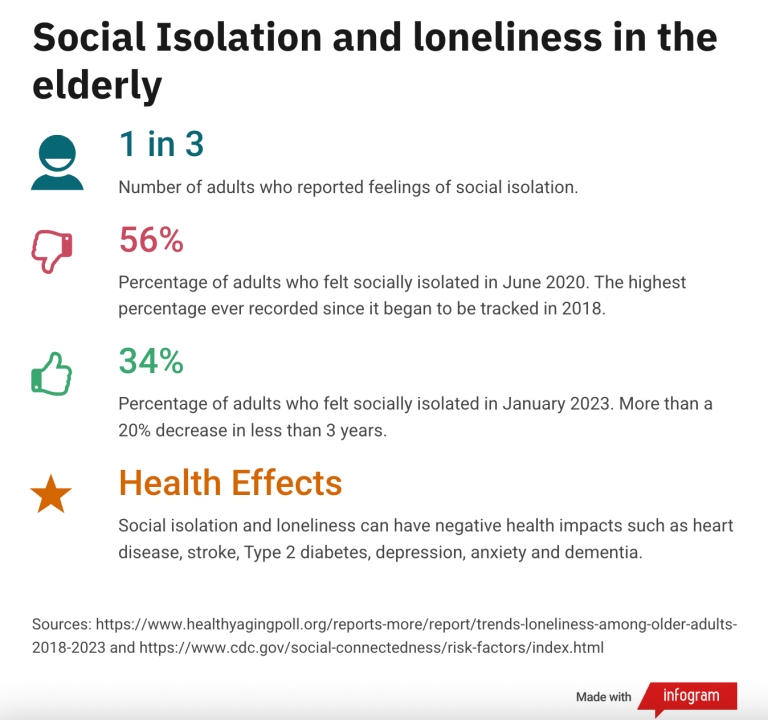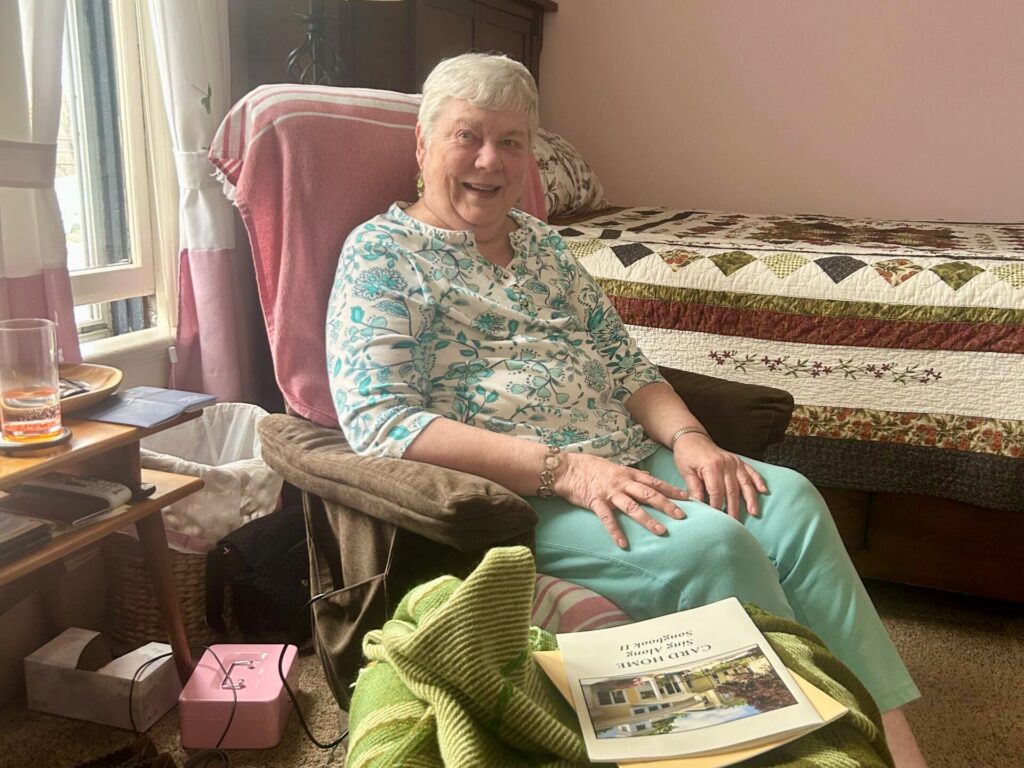By Joshua Zatulskis | UConn Journalism
May 15, 2025

During the height of the 2020 COVID-19 pandemic, residents at Card Home for the Aged in Willimantic often gathered in the dining room to sing their favorite songs from the 1960s, like “Brown Eyed Girl” and “Can’t Help Falling in Love.”
“It doesn’t have to be pretty, it was just something to do,” resident Gunnel Stenberg recalls.
The singalongs were a way to combat a serious side-effect of the pandemic lockdowns. COVID likely contributed to an increase in social isolation and loneliness among nursing home residents, researchers at McMaster University in Canada found in 2021. Older people were hit the hardest socially by COVID rules that limited or barred visits from family and friends.
Although the pandemic is to blame for a big increase in social isolation, there may be other reasons such isolation has become prevalent. According to the CDC, about one-third of adults report feelings of social isolation. These feelings can have negative health impacts that include heart disease, stroke, Type 2 diabetes, depression, anxiety and dementia.
Dawn Bakke, intern administrator at Card Home for the Aged, says she believes family plays a big part.
“It depends on the amount of family someone has. Now with the Boomers getting older, you see a lot of people who don’t really have family. I would say with that generation there’s more of an uptick,” Bakke said.
The job for retirement home staffers is to become like a family to the residents. For some people, coming into a retirement home is their first time living alone. Bakke says she believes giving residents opportunities and different things to do enables everyone to feel more connected.

At Card Home for the Aged, which caters to independent retirees who can pretty much take care of themselves and are in good health, opportunities abound to socialize and get out of the room.
Dial-A-Ride is offered for anyone 65 and older who can call ahead to be picked up to be driven to different appointments. During the holidays, tables are set up and decorated to make residents feel like they’re at home.
A common area gives residents time to work on puzzles or just chat. A nearby TV room features a weekly Friday night movie and has “Jeopardy” and “Wheel of Fortune” watch parties during the week. People from the Willimantic Library show up twice a month so residents can borrow books.
Just a mile away, residents at St. Joseph Living Center in Windham are more reliant on the staff. The average age of the center’s 110 residents is 85–88 years old, and the level of independence is lower than that of many other retirement homes.
Still, the center puts out an activity calendar that gets posted on every resident’s door.

Morning and afternoon activities are offered every day, and musicians, caricatures artists and pet therapists visit to keep residents entertained.
“You’re able to live out your life with some socialization, some medical support, some overall support of your well-being,” the activities director at St. Joseph Living Center, Tracey Megson, said. “Socially, you’re not isolated, we give you a sense of purpose.”
The goal is to get residents to interact with each other or become engaged in activities to combat any feelings of loneliness.
Such efforts at social interaction appear to have made a difference, as researchers have noted a sharp decline in feelings of isolation in recent years. According to a poll from the University of Michigan, the feelings of social isolation among adults ages 50–80 have decreased from 56 percent in mid-2020 to 34 percent in January 2023.
All activities are optional, but Bakke urges her residents to make an effort. Still, some residents don’t need a social life inside retirement homes.
Gunnel Stenberg, an 80-year-old who completes more in a day than many college students, still does the bookkeeping at a printing business that her daughter now runs. She still has her own car and drives; she gets to see her daughter every time she goes into the store.
She is also part of what she describes as a “lions club,” where she meets her friends at a sports bar and they drink and do other activities together.
“I do a lot of things outside of here, but I get along great with the staff. They are great, and they are the ones that I’m dependent on,” Stenberg said.
Prior to moving into the Card Home, Stenberg lived by herself not far from her current address. When her last dog died, she wanted to keep living by herself but knew it was time to move on. She knew about the Card Home because when she was working in her print shop, the former owner ordered some ads printed for the retirement home. Stenberg made the move in 2019, so during the pandemic she didn’t have to go out and risk getting ill. When the COVID vaccine became available, she was immediately provided one as part of the $3,071 rent.
“Thank God I lived here during the pandemic,” she said.
Stenberg has no plans to leave the retirement home. She says it’s a relief for both herself and her family that she is in a place where there is always staff around to check on her. Her family will never have to worry about her carrying groceries from the store or no one being there if she falls down the stairs.

But socializing isn’t easy for everyone, and some people have a harder time adjusting to a new place or leaving their family.
According to a study by the National Academies of Sciences, Engineering, and Medicine, older adults are at increased risk for social isolation and loneliness because they are more likely to face things such as living alone, the loss of family or friends, chronic illness and sensory impairments. Social isolation and loneliness may be chronic or occur in episodes, but that depends on an individual’s circumstances.
Megson at the St. Joseph Living Center says she believes one of the barriers to getting residents involved is that it’s difficult to cater to the needs of all residents at the same time.
“Sometimes a barrier is the person themselves coming to a point of realizing they are limited,” she said. “Their mind is still with us, but their body is limited. We do have people who feel a little bit hopeless, they struggle giving up their independence.”
